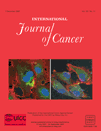Endogenous sex hormones, prolactin and mammographic density in postmenopausal Norwegian women
Abstract
The associations between endogenous sex hormone levels and breast cancer risk in postmenopausal women are well established. Mammographic density is a strong risk factor for breast cancer, and possibly an intermediate marker. However, the results from studies on the associations between endogenous sex hormones and mammographic density are conflicting. The authors examined the associations between circulating levels of sex hormones, sex hormone binding globulin (SHBG) and prolactin and mammographic densities among postmenopausal women not currently using postmenopausal hormone therapy (HT). The authors also examined if insulin-like growth factor-I (IGF-I) levels influenced the association between estrogen and mammographic density. Altogether, 722 postmenopausal participants in the Norwegian governmental mammographic screening program had endogenous hormone concentrations measured. Mammograms were classified according to percent and absolute mammographic density using a previously validated computer-assisted method. After adjustment for age, number of children, age at menopause, body mass index and HT use, both plasma concentrations of SHBG (p-trend = 0.003) and estrone (p-trend = 0.07) were positively associated with percent mammographic density. When the analyses were stratified according to median IGF-I concentration, the weak association between estrone and mammographic density was strengthened among women with IGF-I levels below median, while the association disappeared among women with over median IGF-I levels (p for interaction = 0.02). In summary, the authors found a positive association between plasma SHBG levels and mammographic densities among 722 postmenopausal Norwegian women not currently using HT. Further, the authors found a positive but weak association between plasma estrone concentration and mammographic density, which appeared to be modified by IGF-I levels. © 2007 Wiley-Liss, Inc.




